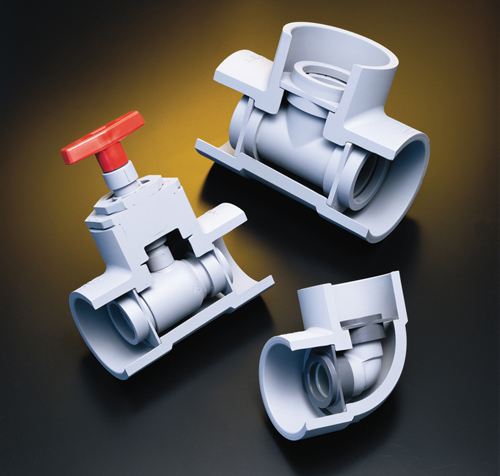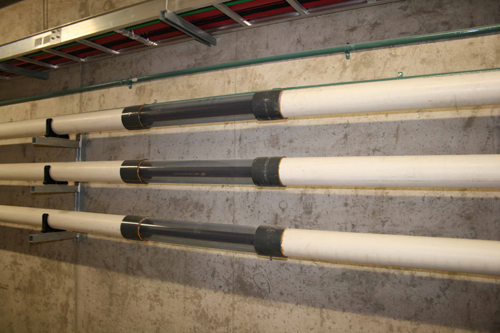Thermoplastic Double Wall Piping Systems—What You Need to Know
By Steven Dolejsi, Applications Engineer, IPEX USA, LLC
Double wall piping systems are essentially a piping system within a piping system. The inner pipe is referred to as the “primary” pipe, while the outer pipe is referred to as the “secondary” or “containment” pipe. The goal of double wall piping is to create a failsafe system where the secondary containment piping would contain any leaked fluid if a failure occurred in the primary piping. Available in a variety of materials, double wall piping systems are ideal for many applications.
When is Double Wall Piping Required?
The majority of double wall piping systems installed in water and wastewater treatment facilities are mandated by the U.S. Environmental Protection Agency (EPA). The EPA requires that all piping systems conveying hazardous wastes listed or identified under Subtitle C of the Solid Waste Disposal Act, or a mixture of such hazardous waste and other regulated substances, comply with Section 280.42 Requirements for Hazardous Substance Underground Storage Tank (UST) Systems. This section indicates that underground piping must be equipped with secondary containment systems that:
- Contain regulated substances until they are detected and removed
- Prevent the release of regulated substances to the environment at any time during the operational life of the UST system
- Must be checked for evidence of a release at least every 30 days.
According to the EPA requirements, underground piping that conveys regulated substances under pressure must also be equipped with automatic leak detection.

What is Automatic Leak Detection?
Automatic leak detection systems monitor the interstitial space in a double wall piping system. The leak detection system is fully automated, failsafe and can often be integrated into a plant’s programmable logic controller (PLC) or supervisory control and data acquisition (SCADA) system for computer-based monitoring and control. If a leak occurs in the primary pipe, the automated leak detection system will alert an operator by means of a visual and/or audible alarm. The two most common systems available are electronic low point leak detection and continuous electronic leak detection.
The operating theory behind electronic low point leak detection is to create “zones” in a double wall system. This is accomplished by installing leak detection stations at specified locations. Leak detection stations are essentially a drip leg in the secondary containment piping where fluid accumulates if there has been a leak in the primary piping. Each leak detection station is monitored with an electronic sensor, and a variety of sensing systems are available. Most systems require the sensor to be in contact with the leaked fluid to send an alarm. There are also systems that employ a proximity sensor that can detect fluid through the wall of the pipe, without coming into contact with the fluid. These sensors eliminate compatibility issues, optimize functionality and render the sensors re-usable and virtually maintenance free.
Continuous electronic leak detection systems employ a sensing cable. The electrical properties of the cable are altered when it comes into contact with a liquid. The sensor cable is pulled through the interstitial space of the piping after installation and rests on the bottom of the secondary piping. It is important to consider the size of the secondary pipe when using continuous electronic leak detection systems—the interstitial space must be large enough to allow the sensing cable and associated connectors to be properly installed.
It is good practice to incorporate visual leak detection along with automatic leak detection. This allows an operator to verify alarms visually before taking corrective action.
Do I Only need Double Wall Piping and Leak Detection for Underground Piping?
Although the EPA may not require the use of double wall piping above ground, safety issues have become a serious concern in North America. The combined cost of litigation, clean up and increasingly stringent safety guidelines have necessitated the use of failsafe double wall systems for above ground hazardous piping systems. It is good practice to employ automatic leak detection in above ground systems by means of electronic low point or continuous electronic leak detection. Clear PVC can be employed for instant visual leak detection in above ground systems to ensure corrective action is taken immediately.

What Materials are Available as Double Wall Piping?
There are a variety of materials available in thermoplastic double wall piping systems, ranging from Polyvinyl chloride (PVC) and chlorinated polyvinyl chloride (CPVC), to polypropylene (PP), polyethylene (PE) and even polyvinylidene fluoride (PVDF). Choosing the correct material for both the primary and secondary system depends on the pressure, temperature and compatibility with the service fluid.
Many applications may use the same material for both the primary and secondary pipe but employ a thinner wall for the secondary pipe to provide material savings. One example would be a CPVC schedule 80 x CPVC schedule 40 double wall system. This practice is often acceptable since the secondary pipe is not required to operate under pressure for a prolonged period of time. It is also possible to use different materials for the primary and secondary piping for maximum performance while further minimizing material cost. For example, a primary CPVC schedule 80 pipe may be contained in a secondary PVC schedule 40 pipe where the CPVC is compatible with a chemical under pressure or at elevated temperatures, and the PVC is compatible only at drainage pressures and at ambient temperature.
Can I Build a Double Wall System?
With double wall piping systems, engineers do not design two separate single-wall systems but rather a combination of the two. The primary and secondary piping of a double wall systems are interrelated, where changing conditions continually affect both pipes. It is therefore critical to have double wall systems professionally designed by an experienced engineer and assembled at the factory by an experienced manufacturer.
Steven Dolejsi is an Applications Engineer with IPEX USA, LLC in Mississauga, ON. Steven received a B.S. degree in Mechanical Engineering from Ryerson University. He has over 7 years of experience in thermoplastic piping system design and application and has assisted in material selection and design for multiple water and wastewater treatment facilities across the United States.
